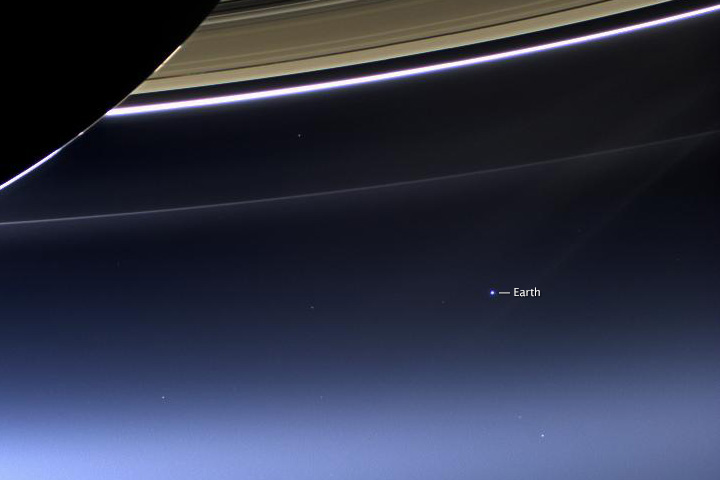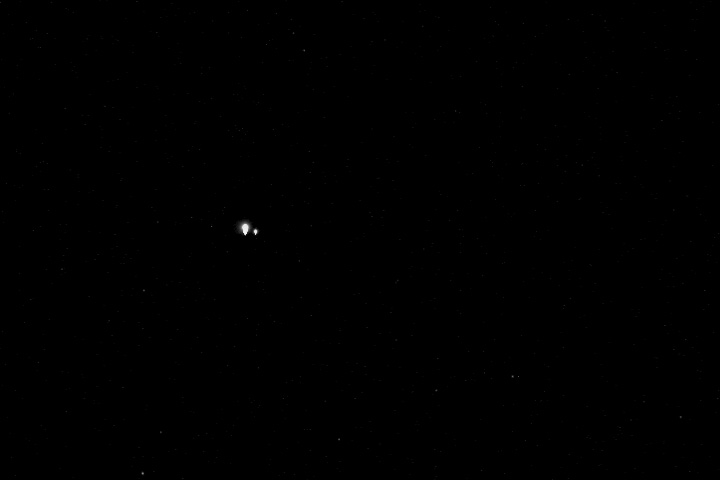NASA: Views of a Distant Earth - 2013
Posted by Ricardo Marcenaro | Posted in NASA: Views of a Distant Earth - 2013 | Posted on 16:20
On July 19, 2013, NASA spacecraft got
not one but two rare and unique views of Earth from opposite ends of
the solar system. While exploring Saturn, NASA’s Cassini spacecraft took the top image of Earth from a distance of about 1.45 billion kilometers (898 million miles) away. NASA’s MESSENGER spacecraft was 98 million kilometers (61 million miles) from Earth, in orbit around Mercury, when it acquired the lower image.
The Cassini view is the third-ever image of Earth from the outer solar system. Views of Earth from distant planets are rare because our planet is so close to the Sun. Sunlight would damage the spacecraft's sensitive imagers, so they are rarely pointed homeward. On July 19, however, Cassini was positioned so that Saturn blocked the Sun’s light while Earth was within the spacecraft’s field of view. Sunlight glimmers around the giant planet’s limb and lights its icy, dusty rings. The sunlit Earth is light blue. The Moon is a faint white dot to the side, but is more clearly visible in the narrow-angle camera view.
Cassini was launched in 1997 to study Saturn and its moons and rings. The July 19 image that includes Earth was part of a wider mosaic of the Saturn system as it was backlit by the Sun. This view will allow scientists to see particles and patterns in Saturn’s rings that are not often visible. The mosaic will take weeks to compile.
On the other side of the solar system, MESSENGER (Mercury Surface, Space, Environment, Geochemistry, and Ranging) was looking for potentially dim, small moons around Mercury when it acquired the lower, black and white image. The sensor required a long exposure time to capture these dim objects, which means Earth and Moon are overexposed. They appear exceptionally bright and large when, in reality, both are less than a pixel in size in this image.
“Cassini’s picture reminds us how tiny our home planet is in the vastness of space, and also testifies to the ingenuity of the citizens of this tiny planet to send a robotic spacecraft so far away from home to study Saturn and take a look-back photo of Earth,” said Cassini project scientist Linda Spilker. That observation holds true for the view from Mercury, as well.
The Cassini view is the third-ever image of Earth from the outer solar system. Views of Earth from distant planets are rare because our planet is so close to the Sun. Sunlight would damage the spacecraft's sensitive imagers, so they are rarely pointed homeward. On July 19, however, Cassini was positioned so that Saturn blocked the Sun’s light while Earth was within the spacecraft’s field of view. Sunlight glimmers around the giant planet’s limb and lights its icy, dusty rings. The sunlit Earth is light blue. The Moon is a faint white dot to the side, but is more clearly visible in the narrow-angle camera view.
Cassini was launched in 1997 to study Saturn and its moons and rings. The July 19 image that includes Earth was part of a wider mosaic of the Saturn system as it was backlit by the Sun. This view will allow scientists to see particles and patterns in Saturn’s rings that are not often visible. The mosaic will take weeks to compile.
On the other side of the solar system, MESSENGER (Mercury Surface, Space, Environment, Geochemistry, and Ranging) was looking for potentially dim, small moons around Mercury when it acquired the lower, black and white image. The sensor required a long exposure time to capture these dim objects, which means Earth and Moon are overexposed. They appear exceptionally bright and large when, in reality, both are less than a pixel in size in this image.
“Cassini’s picture reminds us how tiny our home planet is in the vastness of space, and also testifies to the ingenuity of the citizens of this tiny planet to send a robotic spacecraft so far away from home to study Saturn and take a look-back photo of Earth,” said Cassini project scientist Linda Spilker. That observation holds true for the view from Mercury, as well.
References
- EarthSky (2013, July 23) Earth seen from Saturn July 19, 2013. Accessed July 23, 2013.
- NASA (2013, July 18) NASA interplanetary probes to take pictures of Earth from space. Accessed July 23, 2013.
- NASA Jet Propulsion Laboratory (2013, July 22) NASA releases images of Earth taken by distant spacecraft. Accessed July 23, 2013.
- Johns Hopkins Applied Physics Laboratory (2013, July 22) Looking back at us. Accessed July 23, 2013.
Cassini image courtesy
NASA/JPL-Caltech/Space Science Institute. MESSENGER image courtesy
NASA/Johns Hopkins University Applied Physics Laboratory/Carnegie
Institution of Washington. Caption by Holli Riebeek.
- Instrument:
- Cassini
NASA: Views of a Distant Earth - 2013
You have an alphabetical guide in the foot of the page in the blog: solitary dog sculptor
In the blog: Solitary Dog Sculptor I, the alphabetical guide is on the right side of the page
Thanks
Usted tiene una guía alfabética al pie de la página en el blog: solitary dog sculptor
En el blog: Solitary Dog Sculptor I, la guia alfabética está en el costado derecho de la página
Gracias
Ricardo M Marcenaro - Facebook
Blogs of The Solitary Dog:
solitary dog sculptor:
http://byricardomarcenaro.blogspot.com
and
Solitary Dog Sculptor I:
http://byricardomarcenaroi.blogspot.com
Para:
comunicarse conmigo,
enviar materiales para publicar,
propuestas comerciales:
marcenaroescultor@gmail.com
For:
contact me,
submit materials for publication,
commercial proposals:
marcenaroescultor@gmail.com
Diario La Nación
Argentina
Cuenta Comentarista en el Foro:
Capiscum
My blogs are an open house to all cultures, religions and countries. Be a follower if you like it, with this action you are building a new culture of tolerance, open mind and heart for peace, love and human respect.
Thanks :)
Mis blogs son una casa abierta a todas las culturas, religiones y países. Se un seguidor si quieres, con esta acción usted está construyendo una nueva cultura de la tolerancia, la mente y el corazón abiertos para la paz, el amor y el respeto humano.
Gracias :)
Solitary Dog Sculptor I:
http://byricardomarcenaroi.blogspot.com
Para:
comunicarse conmigo,
enviar materiales para publicar,
propuestas comerciales:
marcenaroescultor@gmail.com
For:
contact me,
submit materials for publication,
commercial proposals:
marcenaroescultor@gmail.com
Diario La Nación
Argentina
Cuenta Comentarista en el Foro:
Capiscum
My blogs are an open house to all cultures, religions and countries. Be a follower if you like it, with this action you are building a new culture of tolerance, open mind and heart for peace, love and human respect.
Thanks :)
Mis blogs son una casa abierta a todas las culturas, religiones y países. Se un seguidor si quieres, con esta acción usted está construyendo una nueva cultura de la tolerancia, la mente y el corazón abiertos para la paz, el amor y el respeto humano.
Gracias :)




Comments (0)
Publicar un comentario